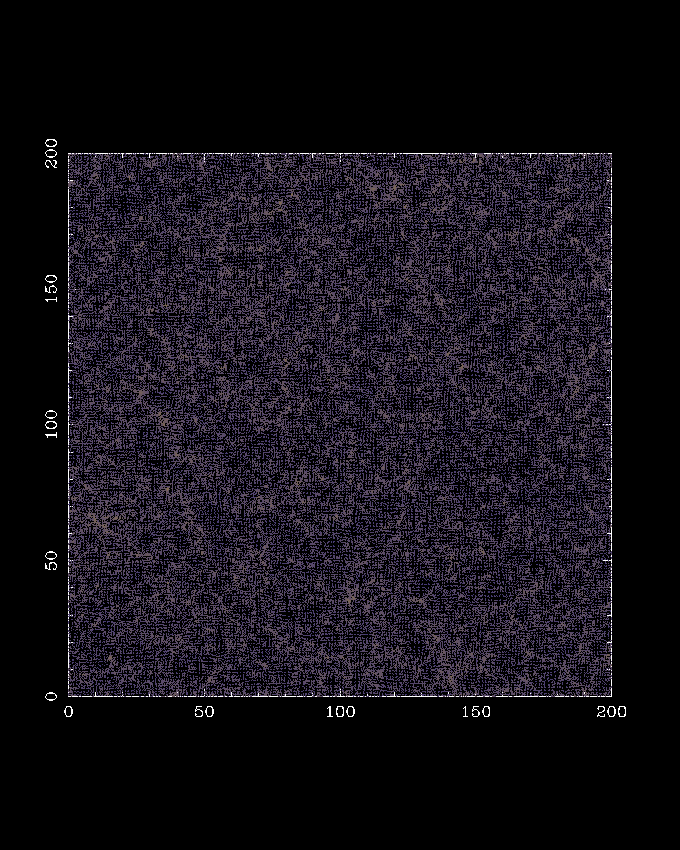N-Body Simulations
My Ph.D work
For my Ph.D thesis (for a PDF click here ), I worked on some aspects of gravitational clustering in an expanding universe. A brief introduction of the problem is as follows.
In the standard model of the origin and evolution of the Universe (called the big bang theory), the Universe originated from a singularity around 13.7 billion years ago, and since then it has been expanding and cooling. The expanding model of the Universe is strongly supported by many observations including redshiting of light coming from distant galaxies (which is interpreted as the expansion of the universe), presence of the Cosmic Microwave Background Radiation or CMBR (which is interpreted as the fossil radiation of the hot past of the universe), chemical abundance of the light elements like H, D, Li and He (which confirms the models of nucleosyntheis in the framework of the Big Bang Theory) and distribution of galaxies in the local universe. Apart from the above, other observations show that the energy of the universe is dominated by a form of matter which does not radiate (called the dark matter) and a form of energy which accelerates the expansion of the universe by producing repulsive gravity (called dark energy).
Observations show that the early universe was devoid of structures like galaxies, clusters of galaxies etc. However, there were small fluctuations present in the matter (signatures of which can still be found in the form of CMBR anisotropies) which amplified due to gravity and gave rise to galaxies, clusters of galaxies and other structures which we see in the local universe. One of the outstanding problems in cosmology which remains unsolved is to precisely understand how the amplification of the primordial fluctuations took place in the framework of the big bang model.
The growth of primordial density perturbations by gravitational amplification is a non-linear process and so it is not a surprise that it cannot be modeled analytically. So far most of the progress in this direction has been made using numerical models or by simulating the gravitational clustering of matter (most of which is dark) called the Cosmological N-body simulations. In a typical N-body simulation we evolve the trajectories of a very large number particles (which represent the matter distribution) in an expanding background by solving dynamical equations (Poisson's equation, Newton's equation etc.) numerically. One of the projects on which I worked for my Ph.D thesis was to understand the effects of perturbations (fluctuations) on one scale on the growth of the perturbations at other scales i.e., mode coupling. Another project on which I worked for my Ph.D thesis was to understand the effects of finite volume in cosmological N-body simulations. A brief summary of the above two projects is as follows.
1. Role of substructure in gravitational clustering :
As has been mentioned above that the major component of the universe, named the dark matter, does not interact with photons but plays an important role in the gravitational clustering of normal matter, which results in the formation of visible structures like galaxies and clusters of galaxies. Dark matter particles (about which we know almost nothing !) can be considered hot or cold on the basis of weather they cluster at very small scales also or not. At present most observations support the models with cold dark matter in which firstly clustering of matter takes place at small scales and then moves upward towards larger and larger scales i.e., the hierarchical clustering. Since in the cold dark matter models clustering at small scales take place first, or the perturbations at small scales collapse first, it is a relevant question to ask that what role perturbations at small scales play in the collapse of perturbations at larger scales. It is well known that in the nonlinear gravitational clustering that at the level of power spectrum small scale perturbations do not affect larger scale perturbations. In one of the projects I tried to understand that if there are other effects of small scale perturbations or substructures on the collapse of large scale perturbations. The results of various studies which I carried out under this project are published in the following publications.
- Bagla, J. S., Prasad, Jayanti and Ray, Suryadeep, 2005, MNRAS, 360, 194, ( astro-ph/0408429) Gravitational collapse in an expanding background and the role of substructure I: Planar collapse
- Bagla, J. S., Prasad, Jayanti 2008, MNRAS, 1365, 2966 (arXiv:0802.2796 [astro-ph]), Gravitational collapse in an expanding background and the role of substructure II: Excess power at small scales and its effect of collapse of structures at larger scales.
2. Finite volume effects in cosmological N-body simulations
In order to model gravitational clustering cosmological N-body simulation simulate a finite volume of the universe and assume that it is a fair representative of the universe, which may be infinite. This means that in cosmological N-body simulation initial fluctuations at scales larger than the simulation box size are ignored. I tried to understand how various measures of gravitational clustering are affected by the finite volume of the cosmological simulations. The results of the study were published in the following publications.
- Bagla, J. S., Prasad, Jayanti , 2006, MNRAS, 370, 993, (astro-ph/0601320 ), Effects of the size of cosmological N-Body simulations on physical quantities -- I: Mass Function
- Prasad, Jayanti 2007, J. Astrophys.Astron. 28, 117 (astro-ph/0702557), Effects of the size of cosmological N-Body simulations on physical quantities -- II: Halo Formation and Destruction rate
- J.S. Bagla, Jayanti Prasad, Nishikanta Khandai 2009, MNRAS,395,2 (arXiv:0804.1197 [astro-ph]), Effects of the size of cosmological N-Body simulations on physical quantities - III: Skewness.

Animation from a typical cosmological N-body simulations.
My Talks
- Thesis defence talk (gave at Allahabad University)
- A talk on N-body simulations (informal talk gave at Astrophysics deptt. TIFR Mumbai)
- An invited popular talk on Cosmology (gave at C.K. Thakur College Panvel, Maharashtra)